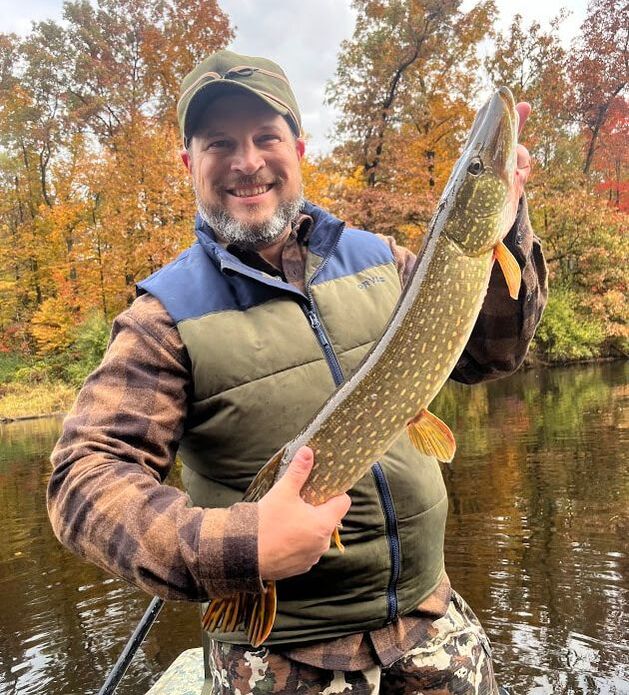|
This article was originally published in the January 2022 issue of Woods-n-Waters News.
By Drew YoungeDyke Cold winter nights make me look forward to warm spring and summer days casting flies to gullible fish, often from behind my fly-tying bench sipping a local Michigan craft beer; there’s little more satisfying in fishing than catching a fish on a fly you tied. Before I started tying two years ago, that seemed like some mystical feat only a Jedi warrior could pull off. I’ve found that it can be simple and achievable, though, especially for the warmwater and coolwater species in most small Michigan lakes. In the two years since I started tying flies with an Orvis starter kit, I’ve tied the trout dry flies and nymphs included in the kit, attempted complicated multi-shank streamers like the Game Changer through Bar Flies nights hosted by Schultz Outfitters, and tried some creative monstrosities that ended up in my Box of Misfit Flies, later to be stripped down to the hook for another try. This winter, I’m focusing on simple, proven flies for the bluegill, bass, and northern pike that I fish for most often. These flies are relatively simple to tie with few materials, though tying them well – with proper silhouette and proportions – takes time and practice. Rather than spending the winter trying to tie complicated multi-material flies that are probably beyond my current ability, I’m focusing on improving how I tie these simple flies. They’re also good flies for beginners to tie and catch fish on to build confidence – and have a lot of fun - in both fly tying and fly fishing. Bluegill, Pumpkinseed, Crappie, Perch Flies Bluegills, pumpkinseeds, crappies, perch, and other panfish are a blast to catch on the fly. Especially in the late spring and early summer when on their beds, bluegills are eager eaters and fight hard on a light line. They’ll also take small, simple flies that are fun to tie. The same flies I tie for bluegills have been successful for me for pumpkinseeds, crappies, and perch (and even largemouth and smallmouth bass). I most often fish for bluegill with my toddler son, with a goal to catch fish to show him and let him touch before releasing them. This summer I’m also tying with the goal of letting him try to catch a few on his own. I also like to target panfish off the dock at my family cottage, or catching a few from shore before launching my canoe or float tube to target bass or pike. Wooly Worm The Wooly Worm is a simple, classic fly that was the origin for the Wooly Bugger. Tied on small 3x streamer hooks, it’s an excellent bluegill fly. I tied one in a peacock green chenille with an orange yarn tail and it seemed like I couldn’t let it even drop on the water without a little bluegill taking it. It also caught several pumpkinseeds and a couple perch hanging around the dock at my family’s cottage. In addition to peacock or olive green/orange, I’ll also tie it in yellow/red this winter. Materials: Chenille, hackle, yarn, nonlead wire, small 3x streamer hook Tying process: I wrap 6 to 7 wraps of nonlead wire, depending on the hook size, and tie it in with the thread, then wrap the thread back to the bend of the hook. I cut a small tuft of yarn and tie it in at the tail. This can be longer now and trimmed later. Next, I tie in the small dry fly hackle and chenille, and wrap the thread forward to the just behind the hook eye. Wrap the chenille forward to the eye and tie it down with a couple tight wraps, then trim off the excess in front of the wrap. Palmer the hackle forward and tie it off with a couple tight wraps, and trim off the excess. Whip finish and then trim off the yarn tail in proportion to the fly to fan out. This fly can also be tied with a nonlead bead head. Foam Spider This classic bluegill fly may be one of the simplest flies to tie and can be tied in a variety of colors; I’ll focus on orange and black this winter, maybe green, too. It pretty consistently catches bluegills and pumpkinseeds for me. Last summer, I even caught a 14” smallmouth on a little orange foam spider while fishing for bluegills. Materials: Small dry fly hook, foam, round rubber Tying process: Cut a small piece of foam about the length of the hook, or just a little longer. Taper the head to wedge narrow enough to tie down and round the tail. Start the thread in the middle of the hook and tie down the foam. Tie in two strands of round rubber legs on each side. Move the thread up toward the eye and tie down the narrow strip of foam to form the head. Whip finish. Bully Bluegill Spider This is a new fly for me that I intend to solve a very specific situation. Often when fishing with Noah off a dock or a public fishing pier in a little inland lake, the little bluegills are visible all over. I know I’m on the clock before my toddler loses interest, and I just want to get a fish in front of him quickly. Sometimes I’ve dangled every fly I have in front of these little fish who have seen everything and would probably prefer a little worm, with few takers, as most of my flies are designed to move and, well, they’re just right there. Materials: Small dry fly hook, nonlead wire, chenille, round rubber legs. Tying process: Wrap the nonlead wire toward the bend of the hook and wrap it back over itself to create a small ball. Tie in the thread toward the hook eye and back over and behind the nonlead wire, building a small thread dam behind and in front to prevent the nonlead wire from sliding on the hook. Tie in the chenille behind the nonlead wire and bring the thread up to the front of the hook, about an eye’s length behind the eye. Wrap the chenille tightly over the nonlead wire and down the hook, secure the chenille with a couple tight thread wraps, and cut off the excess. Take a length of round rubber legs and fold it in half. Tie in at the midpoint, which should form a loop of round rubber at the front. Fold this loop back and wrap over it to create a head. Whip finish. Snip the rubber loop and trip the four rubber legs to even lengths. Foam Hopper My friend Dan Macut also ties flies for panfish and is pretty successful at catching them, too. He recommends a simple foam hopper pattern as his first choice. “I use a size 10 streamer hook for most of my panfish flies,” he recommends. “I like a slightly wider hopper and only use one piece of foam folded over trying to keep it thinner allowing for more and better hook-ups. I add some deer hair for wings and keep the rubber legs on the longer side...I think they act like outriggers and to the bugginess of the fly. Colors don't seem to matter, but bright colors help you see your fly. I sometimes pay attention to the hatch and I might try to match the color of their current meal of choice. Last year there were a bunch of black dragonflies on my favorite lake and a black hopper seemed to work better.” Whether you’re just starting out tying flies – or if, like me, you just want to get back to the basics and catch some fish – these simple panfish patterns are easy to tie and effective on bluegills, pumpkinseeds, and black crappie. Pop open a Michigan beverage and tie some up this winter and try them out on some fun and delicious panfish this summer. Next Month: Simple Bass Flies |
AUTHOR
Drew YoungeDyke is an award-winning freelance outdoor writer and a Director of Conservation Partnerships for the National Wildlife Federation, a board member of the Outdoor Writers Association of America, and a member of the Association of Great Lakes Outdoor Writers and the Michigan Outdoor Writers Association.
All posts at Michigan Outside are independent and do not necessarily reflect the views of NWF, Surfrider, OWAA, AGLOW, MOWA, the or any other entity. ARCHIVES
June 2022
SUBJECTS
All
|


 RSS Feed
RSS Feed